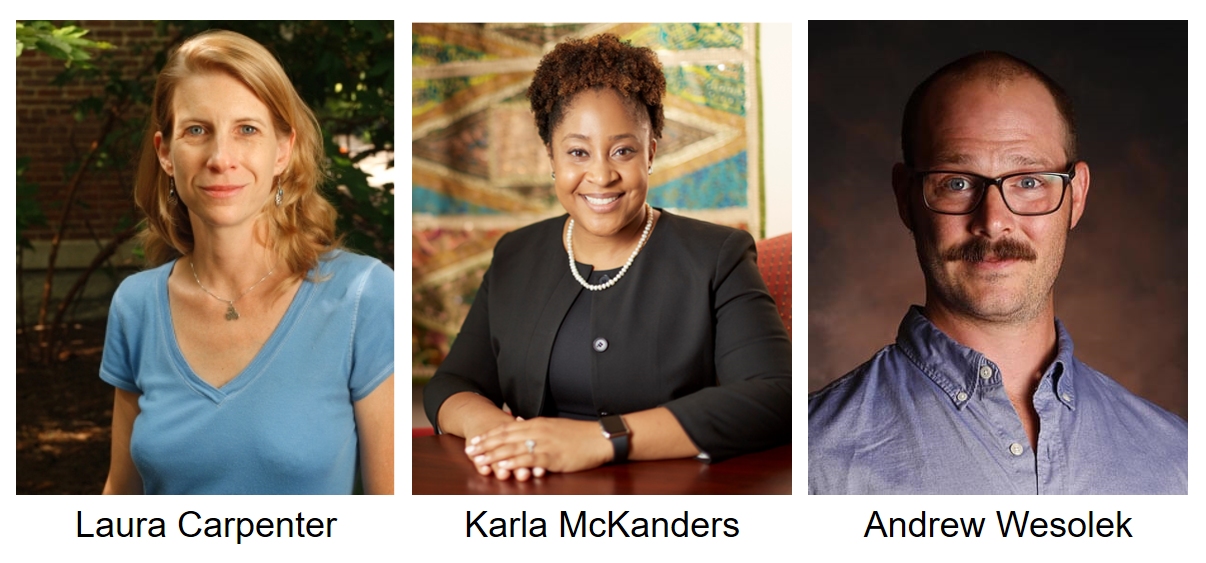A Conversation on Teaching Media Literacy
by Chelsea Yarborough, Graduate Teaching Fellow, and Derek Bruff, Director
On September 14, 2018, the Center for Teaching kicked off its new learning community on teaching digital literacies. With four panelists and a room of ready participants, we engaged in a rich, interdisciplinary conversation about the difficulties and possibilities of teaching media literacy in the classroom. To begin the discussion, Derek Bruff, Director of the Center for Teaching, offered this question to the four panelists: How can we help students become more critical consumers of media and information, particularly in online spaces?
 Claire King, associate professor of communication studies, opened with her gratitude that the conversation was framed with students as both consumers and producers of digital media. She stated, “Consuming itself is a form of production,” noting that the liking and sharing media produces data for the businesses that host that media. King drew on two disciplinary streams, critical rhetoric and critical media studies, to support her opening remarks. She argued that we should teach students about the history of the media they encounter and about the sources of power in the media landscape. She described some of the ways the platforms we use online direct our use of those platforms, often in ways students don’t recognize. And she pointed to traditional forms of rhetorical analysis that continue to be important ways to make sense of digital media.
Claire King, associate professor of communication studies, opened with her gratitude that the conversation was framed with students as both consumers and producers of digital media. She stated, “Consuming itself is a form of production,” noting that the liking and sharing media produces data for the businesses that host that media. King drew on two disciplinary streams, critical rhetoric and critical media studies, to support her opening remarks. She argued that we should teach students about the history of the media they encounter and about the sources of power in the media landscape. She described some of the ways the platforms we use online direct our use of those platforms, often in ways students don’t recognize. And she pointed to traditional forms of rhetorical analysis that continue to be important ways to make sense of digital media.
Lisa Fazio, assistant professor of psychology and human development, answered the question with another question: Why is it hard to process misinformation? To demonstrate that processing misinformation is hard, she led us in an activity in which most of us quickly agreed with the statement the Biblical story of the flood featured Moses, not Noah. The activity showed that most people do not notice discrepancies in the stories they hear, which is how misinformation can first enter the mind. According to Fazio, people only catch 30% of errors such as these, which is why information literacy can be so difficult. Many of the errors that we hope for students to catch slide past their cognitive faculties, especially things that are repeated. As a response, she says that as teachers we should ask students, “How do you know that what you are reading, hearing and/or consuming is true?” This will help them depend on their prior knowledge base and slow down their process of deciphering information in order to catch more errors than they would have otherwise.
With this in mind, Paige Clancy, student media advisor, invited us to consider the importance of curiosity. “That’s what we need from journalists,” she said, like the student journalists she advises at Vanderbilt. She noted how easily doctored photos and videos are shared online, and how some media outlets try to craft narratives without regard for facts. She said that we are “under the weight of digital life,” which makes it critical for students to learn strategies and best practices for engaging with media. She provided three suggestions to resist poor media literacy practices based on her work with student journalists: show students how media is created, encourage them to talk to relevant humans instead of taking a report at face value, and involve students in debunking projects like International Fact-Checking Day.
To close out the opening remarks, Frank Lester, librarian for government information, laid out the expansive nature of the problem. He reminded us of the mass consolidation and what he called “cannibalization” of major media companies and corporations. In the past, the news came from a much wider range of resources but the larger corporations have bought out so many of the smaller ones that the sources are exponentially more limited. He also named the decline in newspaper circulation and the reality that many people are getting their news from Facebook and YouTube. Lester’s remarks helped to frame the challenge that educators face as they help students understand the media landscape.
The rest of the conversation with the panelists and the participants in the room centered heavily on resources that respond to the challenges that we know are prevalent in the arena of media literacy. Several language instructors noted that students are often able to be more objective and critical in their second language than in their first. As a result, having students work with media in other languages can help. More generally, asking students to step out of their own habits and their own culture (“strange-ification,” as one instructor put it) can provide them useful perspectives. Other tactics included
- Asking students to contribute resources to a shared pool, perhaps using a tool like Diigo, and then discussing the credibility of the resources shared during class;
- Exposing students to online resources, such as Hoaxy or Calling Bullshit, that are working to help streamline truth and debunk alternative facts; and
- Having students manufacture media that can then be critically engaged by their peers, since participation as a producer can inform literacy as a consumer.
At the end, we concluded that media literacy is an inescapable and necessary tool for students to gain. However, we don’t just have to figure out what to teach, but how to teach it so that students are not overwhelmed, turned off, or feel hopeless in their ability to consume media well and create media for others. In order to keep the conversation going, one participant asked for a collaborative space so that we could continue to post the resources we find for teaching media literacy. You can find that space, a Diigo group, here. One of the greatest outcomes of the conversation was the interdisciplinary work that happened simply by having different voices in the room. It offered an opportunity to learn strategies from different disciplines and to name the commonalities between us as well. Participants left with strategy, resources and a community to continue to decipher best practices for teaching media literacy.
Join us for the next conversation in this series on October 16th!
A Conversation on Multimodal Assignments
How can we design authentic, multimodal assignments that prepare students to communicate effectively through a variety of media? How can we prepare students to use digital tools not only as consumers of information, but also as producers of knowledge?
Join us for a conversation on engaging students as producers of knowledge through multimodal assignments at the Center for Teaching on Tuesday, October 16, 2018, from noon to 1:30pm.
Our panelists will be:

- Laura Carpenter, associate professor of sociology
- Karla McKanders, clinical professor of law
- Andrew Wesolek, director of digital scholarship and scholarly communications

Leave a Response